Bolette
Background
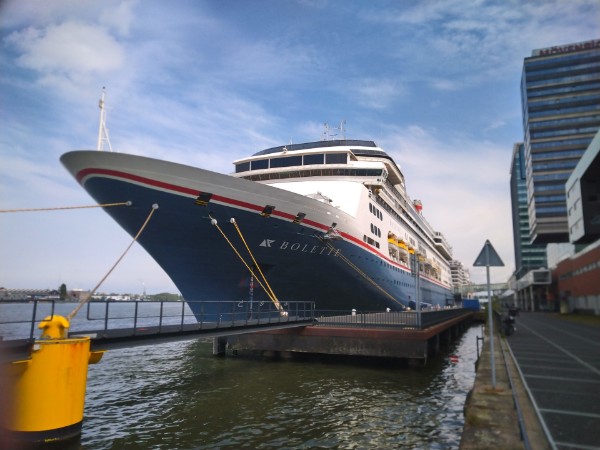
Bolette as seen in her former namesake port of Amsterdam, a name that she carried for Holland America Line between 2000 and 2020. The date here is the 1st of may, 2022.
In The Netherlands, there is a big rivalry between the cities of Amsterdam and Rotterdam. This of course reflects in football, Ajax from Amsterdam against Feijenoord from Rotterdam and in oversentimental feelings overall, but it all originated from the rivalry between the ports of Rotterdam and Amsterdam. Holland America Line of course was based in Rotterdam, but also had a small flirt with Amsterdam and even offered line-voyages to America from the Dutch capital in the 1870's because the connection to the sea was better from Amsterdam. There was even considered that Amsterdam should replace Rotterdam as homeport of the HAL overall. Maybe this rivalry between the ports was also the reason that the company hadn't named many ships for the Dutch capital city. In 1879, the company launched the first Amsterdam of nearly 3.000 tons. At the time it was the largest ship in the fleet. She sailed for a short while, as she ran aground in thick fog close to Sable Island, Nova Scotia in july 1884. Three years later, a new Amsterdam was added, again the largest ship of the fleet with 3.600 tons. She had also been built in 1879 as British Crown and was finally demolished at Genoa, Italy in 1905. Afterwards, Holland America Line decided to not re-use the name as the favoured the name Nieuw Amsterdam, the former Dutch colony which is now New York. It took untill the end of the 1990's, almost 100 years, before Amsterdam was again part of the Holland America fleet.
In 1996, the sixth Rotterdam was launched from the Fincantieri wharves at Marghera, Italy and never before a ship named Rotterdam had any sisterships. But now, this changed as the ship recieved three sisters. In 1998, the thirth Volendam was launched, followed by the thirth Zaandam in 1999. These two later ships differed in design from Rotterdam, as they only sported just one normal funnel instead of the characteristic double uptakes from Rotterdam. They were also not named flagships of the fleet, but in january of 2000, Rotterdam recieved a true sister that also had the twin uptakes and also shared the flagship title and for once, the both rival portcities of The Netherlands were truly united...
As a Holland America Line ship, Amsterdam only twice visited her homeport in Rotterdam, as she was mostly seen on the other side of the world. The date of the following pictures is the 31st of may 2001, the first time she had come in during her first season.
Construction and general statistics
Well.., not exactly... As the new ship was to be registered at The Bahamas with homeport Nassau, there was a small problem because the name for the new ship was planned to be Amsterdam. In the shipregistry from The Bahamas, there was already a ship named Amsterdam so it wasn't possible to use the name. The choice was to just put a '1' behind the name for the time being.
Amsterdam 1 floated out of her buildingdock at the Marghera Yards at the 7th of january 2000. She was larger then
Rotterdam, but smaller then
Volendam and
Zaandam, measuring 60.874 tons. Her lenght was 237,86 meters, she was 32,25 meters wide and her draught was 8,10 meters. The ship was propelled by two Azipod VO units, the first within the fleet, driven by two 16-cylinder and three 12-cylinder diesel engines of Sulzer-GMT design. It makes her capable of a speed of 25 knots, as fast as the
Rotterdam making them both the fastest ships within the fleet. Energy comes from five generators, connected to two electric motors. Her maximum passenger-capacity was 1738, but based on two-per-cabin the number given was 1380. Some 647 crewmembers were also there aboard her twelve decks. She had been built under yardnumber 6052 and as said flew the flag of The Bahamas homeported in Nassau.
As Amsterdam again, during her last visit to her then homeport of Rotterdam at the 15th and 16th of august in 2020, where she would be refitted for Fred Olsen at the yards of Damen.
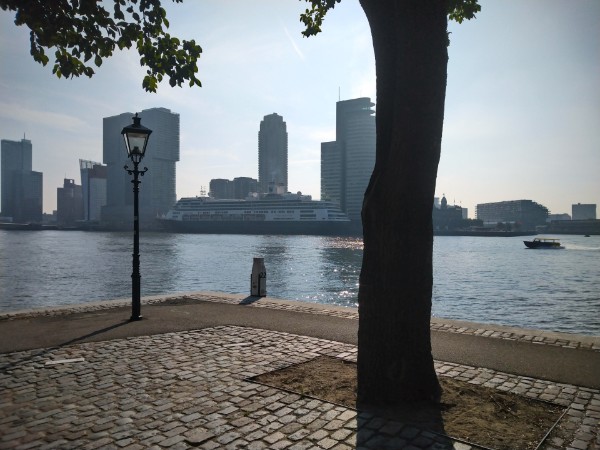
Design
Most visible change from all of her fleetmates, except
Rotterdam, was the twin uptakes used as the funnel. In Rotterdam, it had been added to resemble the 1958-built
Rotterdam that she had replaced, and on
Amsterdam it was fitted to show the double flagship role. But there also is a technical reason, because the aft-decks are higher then aboard the other sisters, this design causes less smoke and smut on the decks below.
Amsterdam 1 also sported a broader and longer hull then the other sisters, as she was built for higher speeds. Untill the promenade deck (4) upwards, the hull slopes inwards for better stability. The draught was also bigger for extra storage of fuel and water, again creating better stability.
Some 81% of the ships staterooms, 557 out of 690, do have ocean views and there is one so-called concierge deck, with two penthouses and 50 suites which have their own Neptune Lounge.
Most spectacular is the specially constructed 9 meter high astrolabe clock-tower leading up to the astrological skies in the ships three-deck high atrium. The atrolabe took around 15 years to built and it resembles an ancient celestial clock with four faces; the astrolabe itself, a planetarium, the world time and an astrological clock. Classically, an astrolabe was used by astronomers, seafarers and astrologists to chart the paths of the sun, moon, stars and planets. In Islamic tradition, it is also used to calculate the qibla, the direction of Mecca which one is to face during the five daily prayers. The astrolabe tower was designed by the Dutch Utrecht-based interiour designcompany VFD from Frans Dingemans, house-designer of the ships of the Holland Anmerica Line. It was finally created by Italian artists Gilbert Lebigre and his wife Corinne Roger and is made of recycled materials, so it is named eco-decor.
Several art-deco sculptures from the multi-million dollar art-collection aboard were originally placed aboard the 1938-built Nieuw Amsterdam and now replaced aboard Amsterdam to give a sence of the history of the line. Also, more contemporary and modern art is placed aboard, but always with a classic feel to it. World-famous maritime artist Stephen Card made several paintings for the ship and the sculpture of two fishing bears by British sculptor Suzanna Holt are watching over the ships lido-deck. Close-by is their cub hiding in one of the alcoves.
Amsterdam was slightly bigger then her older sister, measuring 60.874 tons. Small differences are to be noticed in the exteriours of both ships, especially aft. The ship is 237,80 meters in lenght, she is 32,25 meters wide and her draft is 7,80 meters. Both sisters have 12 decks available to her passengers, of whom a maximum of 1872 can be carried. On the basis of the lower berths, Amsterdam can take on 1380 passengers. Also, there is space for 615 crewmembers. As her sister, the ship is pretty fast, her normal speed is around 25 knots, several knots faster then most modern cruiseliners. It was meant for the ship to be registered in The Netherlands, like the rest of the Holland America fleet, but because there was a small problem with paperwork getting ready on time, she had to be registered at the Bahamas in her first months of service, and she got Nassau as her homeport. This was not the only problem though, because there was already a ship named Amsterdam registered at Nassau. Holland America Line solved the problem by naming her Amsterdam for the time being. The ship offers her passenger a very clssic and sophisticated interiour, designed by the Dutch VFD Architects, based at Utrecht. As a central piece, within the central atrium, an astrolabe measuring three decks in height is placed. This astrolabe took some 15 years to design!
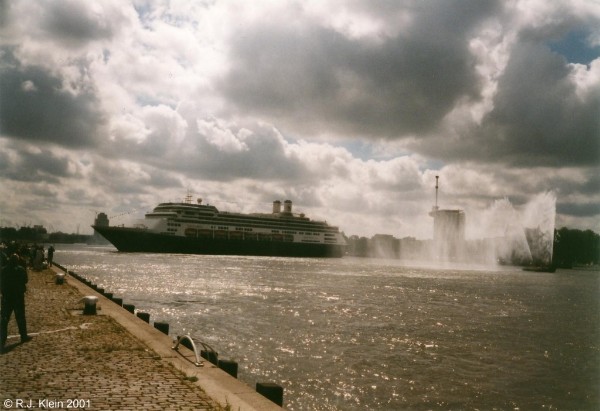
Carreer
Amsterdam 1 was named in Boston in october 2000 by Janet Lanterman and made her first cruise on the end of that month from Fort Lauderdale to Costa Rica. Within a few months time she was ceremoniously reflagged as a Dutch ship and her homeport of Rotterdam appeared on her stern. At that time, it was also possible to get rid of that strange '1' behind the name so she officially became the thirth Amsterdam within the fleet.
For Holland America, the ship mostly sails the Pacific and Eastern Asia, as well as South America and Australia.
In february of 2005, Amsterdam hit the news to show how the most modern cruiseliners and their passengers can still suffer from bad weather. When the ship was anchored near Port Stanley on the Falklands the weather became so bad that she had to lift anchor and seek shelter away from the storm. Because of that, some hundreds of people were not able to get back to the ship and had to stay overnight in Port Stanley. Because of the limited amount of hotelspace on the island, some passengers and crew were invited to stay at residents homes and also, the residents cared for enough food for the hungry guests. The next day, the weather was calmed down and the cruise could be continued, but it was a memory worthwile for those people.
In march of 2020, the world was horrified by a very nasty disease known as COVID-19, originated from a Chinese animal-market but quickly spreading. Onboard several cruiseships also, outbreaks were reported and during may and april, the whole cruise-industry came to a halt.
Amsterdam was sailing her annual world-cruise, but had to aboard in Fremantle, Australia at the 22nd of march. After landing her passengers, the ship went straight back to Fort Lauderdale in Florida and was laid-up there. As the industry was totally stopped and no income was there for the companies, Carnival decided to reduce costs and sell four ships of the HAL fleet simultaniously.
Maasdam and
Veendam were sold to undisclosed buyers.
Amsterdam and
Rotterdam were sold to
Fred Olsen Lines, who announced their new names to become
Bolette and
Borealis, mostly meant for European cruiseservice. In mid-august, both ships sailed for Rotterdam where they were updated for their new owner.
Amsterdam arrived in the port at the 15th of august and was moored at the cruiseterminal one last time so the Dutch public could say goodbye. One day later, she sailed for the Damen Yards for her update, meeting her sister
Rotterdam there who had arrived there a few days earlier.
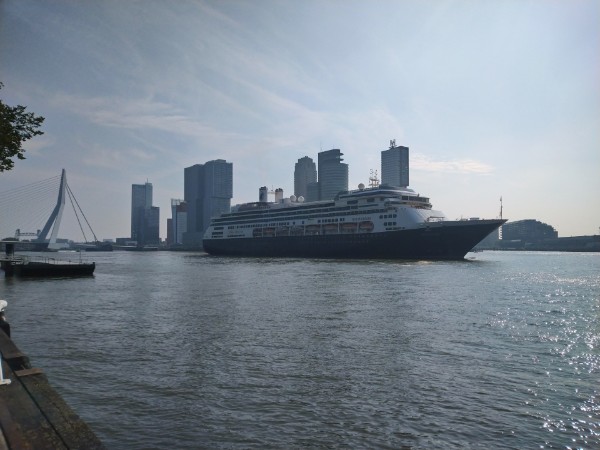
At the first of october 2020, the ship was officially handed over to Fred. Olsen Lines at Rosyth, Scotland as Bolette. She continued here in lay-up with the other ships of the line, shortly afterwards also joined by her sister, now under her new name Borealis. Finally, at the 2nd of november of 2022, when most COVID-19 problems seemed to be under control, the ship started her maiden voyage for Fred Olsen from the port of Southampton, England, which was a voyage to Antwerp and Amsterdam. Afterwards, she started her first season sailing from26 cruises from Southampton to the Mediterranean as well as Norway and Iceland.
The name Bolette was chosen as it was the name of the great-great grandmother of the companies chairman Fred. Olsen Junior.
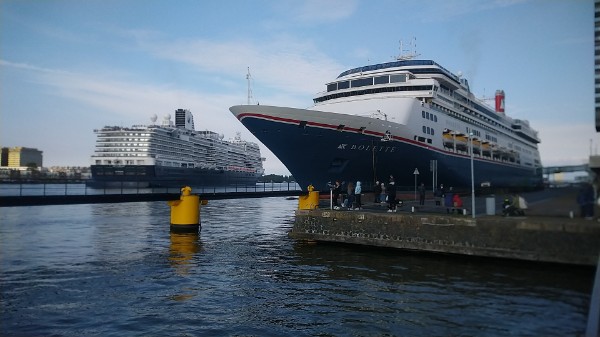
Together with Bolette
, the newest 2021-built Holland America Line ship Rotterdam was also present that 1st of may 2022 and they departed almost simultaniously. 
